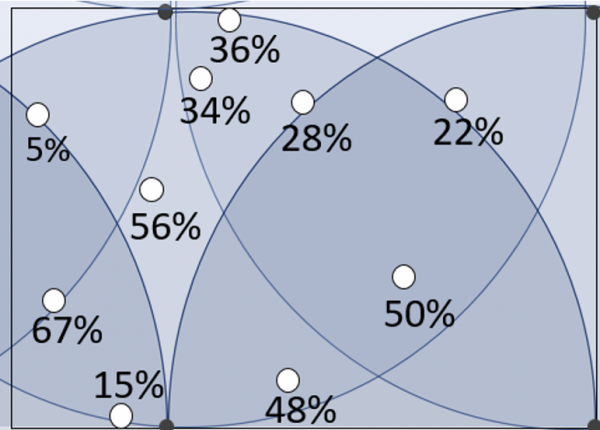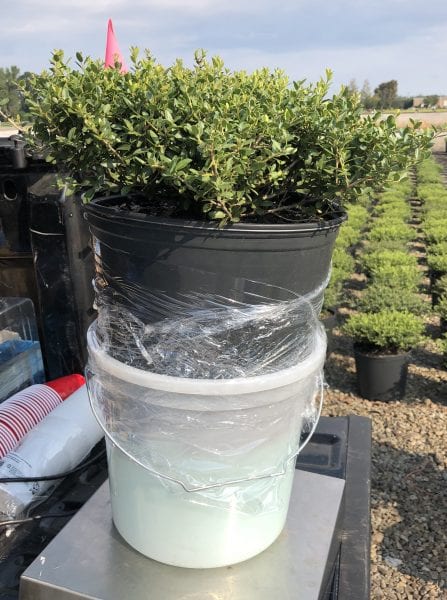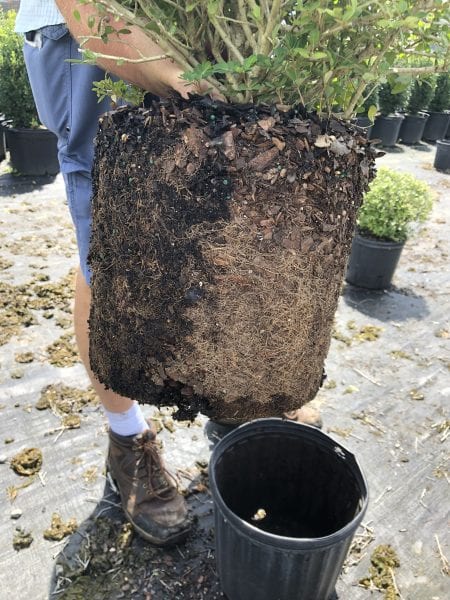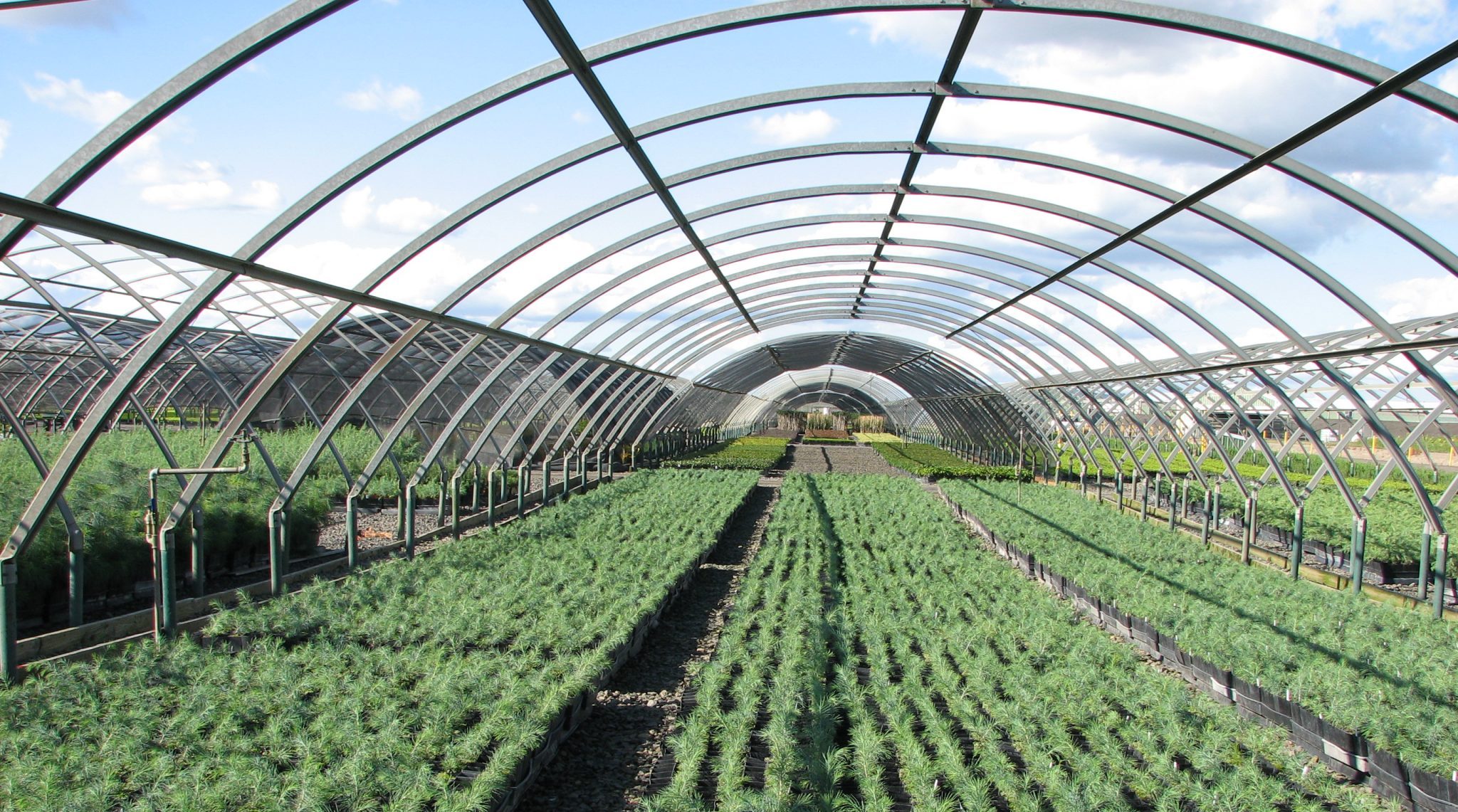Crop Production

This third in a three-part series on auditing overhead irrigation examines why the leaching factor in container production should be low meaning that most of the water that is applied stays in the container.
What Is a Leaching Fraction?
A leaching fraction (LF) is the amount of water that drains from a container compared to the amount of water applied. In container production, LF should be low, meaning that most of the water that is applied stays in the container. High LFs may be a result of overirrigating. Leaching fraction can be used to measure efficiency, but more importantly, it can be used to determine how long to run an irrigation cycle. Best management practices (BMP) developed by the Southern Nursery Association suggest an LF of 15 percent to 20 percent. Some leaching is needed to prevent the buildup of fertilizer salts and to ensure that plants receive enough irrigation.
Reducing LF can decrease runoff from excess irrigation therefore reducing environmental impacts to surrounding water bodies. Added benefits of reducing LF are potential improved growth and reduced production cost. A well-managed leaching fraction can keep more fertilizer in the container and reduce pest pressure. Drier crops can result in lower weed and disease issues. Monitoring LF can determine if plants are receiving too much or too little water and can be used to adjust irrigation run time accordingly.

Figure 1. Leaching fraction map at a nursery with poor distribution uniformity.
A 2019 audit of nine container nurseries in Alabama found that average LF between nurseries ranged from 7 percent to 36 percent, with only 44 percent of the nurseries falling within the best management practice guideline of a ≤15 percent LF. The results of this study also found that LF varied greatly within each nursery, likely because of poor distribution uniformity (DU). Distribution uniformity (DU) is a measure of how evenly water is applied to an irrigated area, and DU should be ~80 percent. In one audit, a nursery had a DU of 66 percent. The low DU led to uneven application and therefore a large range of LFs (figure 1). Some containers in the block had an LF of 5 percent, while others leached more than 67 percent. By improving the DU at this nursery, LFs would be more uniform, allowing a reduced irrigation cycle and a more uniform crop. For more information on how to improve distribution uniformity, see Extension publication ANR-2705, “Auditing Overhead Irrigation Systems in Container Nurseries: Distribution Uniformity.”
Measuring Leaching Fraction
Volumetric Method

Figure 2. Container plant placed in a collection bucket and sealed with plastic wrap. A 6-inch section of PVC pipe was used as a spacer between the plant and the collection bucket. “
Measuring LF in overhead systems requires a few pieces of commonly found equipment: holeless containers or buckets, plastic wrap, garbage bags, and blocks of wood or bricks. To determine LF:
- Before irrigating, select and label 5 to 10 container plants within your irrigation zone. Choose some in the middle and some near the edges.
- Place each container plant inside an empty bucket or holeless version of the same container. You may need to place a block of wood or a PVC ring spacer between the container and the bucket to elevate the container. If necessary, cover the gap between the container and the bucket with plastic wrap (figure 2).
- Next to these containers, place an empty, holeless version of the containers you are using in the block. If you cannot find holeless versions, line a normal container with a plastic garbage bag.
- Run an overhead irrigation cycle as you usually would and allow containers to drain for 30 minutes afterward.
- Measure the amount of water collected in the empty containers in fluid ounces or milliliters. It does not matter what units you use as long as you keep them the same. The water collected in these containers is the total irrigation applied.
- Remove the container plant and measure the leachate collected in the bucket. This is the leachate recovered.
- Using this equation, calculate the LF:
% LF = (leacheate recovered / total applied irrigation) multiplied by 100

- Average the % LF for the entire block.
Weighing Method
- Select 5 to 10 container plants in the block to be tested. Record the weight for each container.
- Place 5 to 10 empty containers of the same size next to the containers being tested for LF. Line the empty containers with a garbage bag. Weigh and record the empty, lined containers.
- Run the irrigation as you would normally and allow the containers to drain for 30 minutes after the irrigation cycle.
- Use the following equations to calculate LF for each pair of containers:
Empty container after irrigation − empty container before irrigation = water applied
Plant weight after irrigation event − plant weight before irrigation = water retained
Water applied − water retained = water leached
% LF = (water leached)/(water applied) × 100
Average the % LF for the entire block. Remove any extreme measurements from the average. Extreme high or low leaching fraction compared to the average merits investigating nearby irrigation heads.
Making Decisions Using Leaching Fractions

Figure 3. Channeling caused by hydrophobic media”
An LF of around 15 percent to 20 percent is considered acceptable by the Southern Nursery Association (BMP). This is high enough to leach away any built-up salts due to fertilization but low enough so that water is not wasted as runoff. An LF of 20 percent or greater may be a result of overirrigation, and irrigation run time should be reduced. A wide range of LF percentages within the same block may indicate that there is a problem with distribution uniformity.
Excess leaching may not be entirely due to overirrigation. High LF can also indicate that the substrate has become hydrophobic and is channeling water or not retaining water properly (figure 3). Plant canopy shape can also influence water capture and leaching. Plants with vase-shaped canopies can capture and leach more water than recorded in the LF test, and those with umbrella-like canopies may deflect water and capture less. These factors must be taken into account when scheduling irrigation based on LF.
After performing an LF audit, use this information to schedule irrigation based on a desired or target LF. Add your current LF, current irrigation time, and target LF in the following equation to find the new irrigation time needed to achieve the desired LF.
New irrigation time (min) = [((100 – actual %LF)) / ((100 – target %LF))] multiplied by actual irrigation time (min)

Conclusion
Periodically checking LF on different crops can ensure that your plants are getting adequate water without leaching excessively. Leaching fraction is also a great tool to help schedule irrigation more effectively. Ideally, by monitoring and managing the irrigation system, a grower can continue to produce high-quality crops while conserving water resources.
Sources
Million, J. and T. Yeager. 2015. Monitoring leaching fraction for irrigation scheduling in container nurseries. IFAS Ext. ENH1268. 24 Apr. 2020. <http://edis.ifas.ufl. edu/pdffiles/EP/EP52900.pdf>.
Examples:
Volumetric Method
- Measure and record the amount of water collected in empty containers as total irrigation applied. Record the amount of leachate recovered from collection buckets:
| Container Number | Total Irrigation Applied (mL) | Leachate Recovered (mL) |
|---|---|---|
| 1 | 1,444 | 65 |
| 2 | 1,209 | 170 |
| 3 | 948 | 162 |
| 4 | 510 | 210 |
| 5 | 621 | 157 |
- Calculate the LF for each:
Container 1: % LF = (65 ÷ 1,444) × 100 = 4.5%
Container 2: % LF = (170 ÷ 1,209) × 100 = 14.1%
Container 3: % LF = (162 ÷ 948) × 100 = 17.1%
Container 4: % LF = (210 ÷ 510) × 100 = 41.2%
Container 5: % LF = (157 ÷ 621) × 100 = 25.3%
- Average the % LF for the entire block: 4.5 +14.1 + 17.1 + 41.2 + 25.3 = 102.2 ÷ 5 = 20.4%
Weighing Method
- Before irrigation, record the weight of each planted container and each empty, lined container:
| Container Number | Postirrigation Plant-Filled Container Weight (g) | Postirrigation Empty Container Weight (g) |
|---|---|---|
| 1 | 3,521 | 22 |
| 2 | 3,953 | 20 |
| 3 | 4,350 | 20 |
| 4 | 4,728 | 19 |
| 5 | 4,693 | 21 |
- After irrigation and allowing the containers to drain for 30 minutes, weigh and record each container again:
| Container Number | Postirrigation Plant-Filled Container Weight (g) | Postirrigation Empty Container Weight (g) |
|---|---|---|
| 1 | 4,900 | 1,466 |
| 2 | 4,992 | 1,229 |
| 3 | 5,172 | 968 |
| 4 | 5,028 | 530 |
| 5 | 5,157 | 642 |
- Calculate the water applied by subtracting the weight of the empty containers before irrigation from the weight of the empty containers after irrigation:
Container 1: 1,466 – 22 = 1444
Container 2: 1,229 – 20 = 1209
Container 3: 968 – 20 = 948
Container 4: 530 – 19 = 510
Container 5: 642 – 21 = 621
- Calculate the water retained by subtracting the weight of the plant-filled containers before irrigation from the weight of the plant-filled containers afterwards:
Container 1: 4,900 – 3,521 = 1,379
Container 2: 4,992 – 3,953 = 1,039
Container 3: 5,172 – 4,350 = 822
Container 4: 5,028 – 4,728 = 300
Container 5: 5,157 – 4,693 = 464
- Calculate the water leached by subtracting the water retained from the water applied:
Container 1: 1,444 – 1,379 = 65
Container 2: 1,209 – 1,039 =170
Container 3: 984 – 822 = 162
Container 4: 510 – 300 = 210
Container 5: 621 – 464 = 157
- Calculate the % LF for each:
Container 1: % LF = (65 ÷ 1,444) × 100 = 4.5%
Container 2: % LF = (170 ÷ 1,209) × 100 = 14.1%
Container 3: % LF = (162 ÷ 948) × 100 = 17.1%
Container 4: % LF = (210 ÷ 510) × 100 = 41.2%
Container 5: % LF = (157 ÷ 621) × 100 = 25.3%
- Average the % LF for the entire block: 4.5 +14.1 + 17.1 + 41.2 + 25.3 = 102.2 ÷ 5 = 20.4%
Scheduling Irrigation Example
- For this example, the target LF is 15 percent. Irrigation run time was 30 minutes. The actual LF was calculated as 20.46 percent.
- New irrigation run time = [(100 – 20.46) ÷ (100 – 15)] × 30 = 28 minutes


